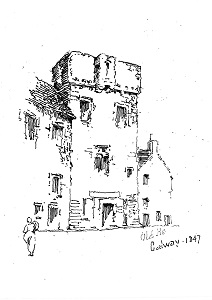A MEDIEVAL CASTLE IN QUAY STREET

by Tom Kenny
Blake’s Castle is a medieval urban fortified town house at the bottom of Quay Street which was built c.1470 with single bay ground and first floors and a two-bay second floor. It has a flat roof with a crenelated parapet with a projecting machicolation on supporting corbels on the top floor above the entrance. This was an opening at the parapet through which defenders could drop material such as boiling water or hot pitch down on would be attackers. It was built with coursed roughly dressed limestone rubble walls with square headed window openings to the upper floors.
According to Hardiman’s History, this castle originally belonged to the O’Halloran Sept. It was then taken over by the Anglo-Norman Blake family. The Blakes were one of the tribes of Galway who owned extensive properties throughout the county, including Menlo Castle. They forfeited this Quay Street castle in 1641 and it was then granted to the Morgan family who were based in Monksfield, but it has always been known as Blake’s Castle.
It features on the 1651 map, and on a later map of 1686, it is listed as the County Gaol, and it served as such until 1810.
In 1788, John Howard described it as follows – “Galway County Gaol is near the river. There is a new court but no pump. The criminals are in two long rooms with dirt floors and no fireplace. The debtors have small rooms above stairs. Allowance to felons, a sixpenny loaf of household bread every other day (weight three pounds twelve ounces) which they often sell for four pence halfpenny for potatoes”. The gaoler’s salary was £20 and on April 1st that year, there were four debtors and seven felons in the gaol.
In 1807, construction work began on the new County and Town gaols which were on the site where the Cathedral is today, and on its completion, the gaol moved from here. It functioned as a corn store at the end of the nineteenth century and then lay derelict for a time. In 1967, the ESB used it as a substation to house a transformer. Sadly, it lay derelict again for a while and looked increasingly sad as the area around it was beginning to develop. In the early nineties, while Jury’s Hotel was being constructed, this castle was cleaned up and now looked like a castle. The recent development on either side is slightly recessed from the tower house elevation making it look more imposing.

So we have two illustrations of the castle for you today. The first was given to us by the National Library and is of a drawing of the façade done in 1847 and the second is a photograph kindly given to us by an old Galwegian who took it in the late seventies. Most of the empty site to the left of the photograph was originally Burke’s Distillery, a major employer in Galway in the early 19th century. When it went out of business, it was taken over by McDonoghs who converted into a chemicals factory which was known locally simply as ‘the chemicals’. Many will remember the wooden black tower perched on the very top of the plant. It was probably the highest building in Galway at the time. There were two small houses just to the left of the castle which were occupied by Bridget O’Connor who had a sweet shop, and by the Monahan family.
Further up Quay Street, you can see McDonagh’s fish shop. The original building there was a garage and haulage store, four storeys high. It was destroyed in 1932 by a bad fire which spread rapidly as there was hay and petrol stored there. The roof fell in and a wall collapsed sending sparks and burning debris scattering over many parts of the town. ”The Fire Brigade kept gallantly on, helmets wreathed in sparks and their playing jets sizzling instantly into steam”. Houses and tenements nearby had to be evacuated until the firemen brought the blaze under control. McDonaghs was reduced to embers. Some time after our photograph was taken, the building we see was demolished and redeveloped into what is there today.
.png)